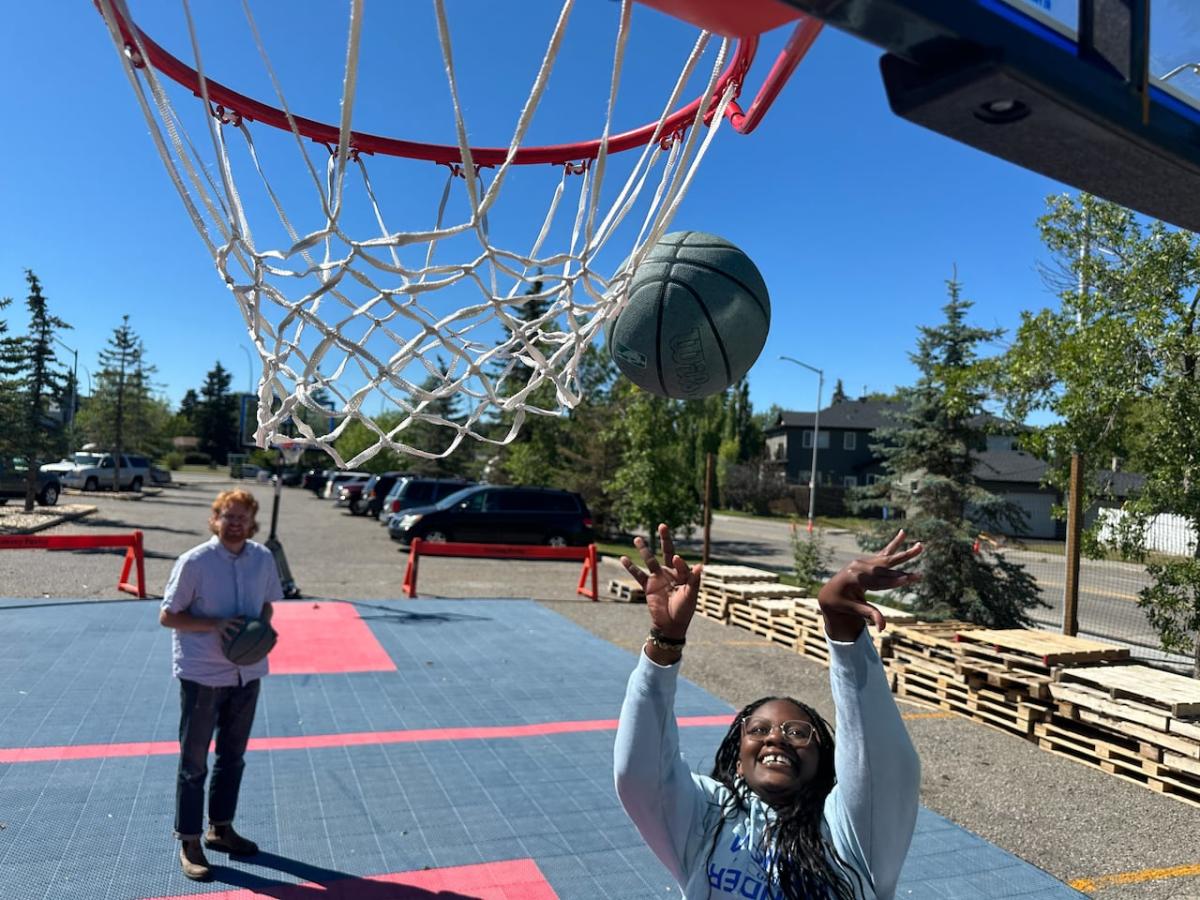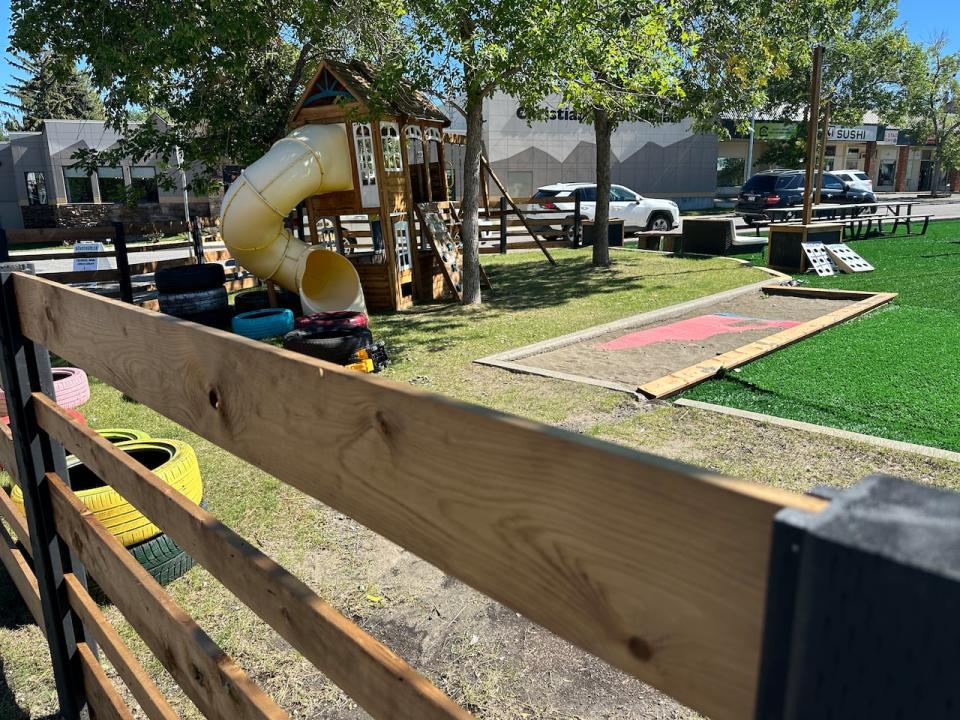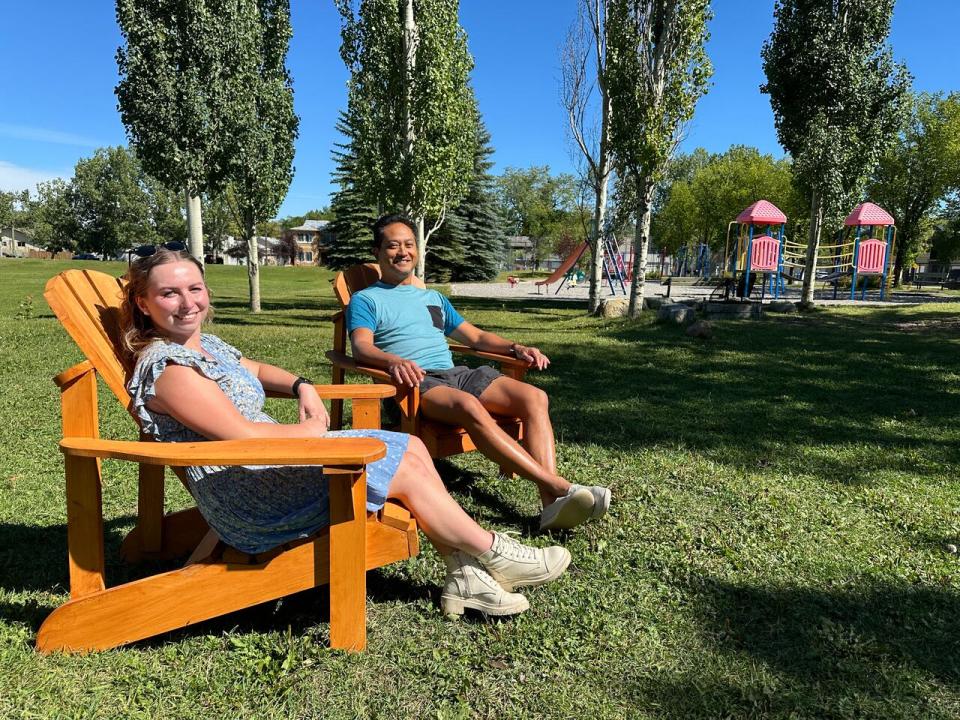



Estela Nadege plays bump with Adam Schwartz in the new public park outside the Christian Life Assembly church in Calgary’s southwest. In bump, if the second player in line sinks the ball before the first player, the first player is eliminated. (Elise Stolte/CBC)
As more people move into Calgary’s inner-city neighbourhoods, community leaders worry they’ll put pressure on park spaces and amenities.
That’s one reason Adam Schwartz is trying to help build new ones. He works for the Federation of Calgary Communities, approving grants and helping volunteers navigate city bylaws to create 30 small park projects a year.
On a recent summer afternoon, he played bump at a basketball court at one such project — a court, picnic area and playground outside the Christian Life Assembly church in Calgary’s southwest.
It was just a parking lot last year. Now, it’s a place where residents can grab sushi or won ton soup at the nearby restaurants, and then meet neighbours and sit on patio furniture as others come out to shoot hoops.
“This project hit my inbox over the winter and then it’s up mid-summer. Like, that’s a quick turnaround to get a brand new community park space. So I think that’s the beauty of tactical urbanism,” said Schwartz, amazed at how fast a project can come together outside a government bureaucracy.
“We’re seeing our city growing … there’s obviously concerns around how packed parks might get, or how overrun infrastructure and amenities might get. It’s super important that communities kind of lead the charge on some of these projects and say what they want and do it.”


This children’s playground is part of a new pop-up community space off Richmond Road in Calgary. From left to right, Adam Schwartz of the Federation for Calgary Communities, urban planning student Jeremy Pham and Christian Life Assembly community outreach director Jordan Illsley. (Elise Stolte/CBC)
City council has been trying to encourage more inner-city density. In Killarney, Glengarry and Richmond, the neighbourhoods around Christian Life Assembly, many bungalows are being torn down and replaced with duplexes or fourplexes. Several large infill sites are slated for highrise towers.
The federation’s ActivateYYC grant offers $1,000 to $5,000 to help community residents add amenities.
It’s not a lot, says Schwartz, but it can be a start. He said the program helped create the first mini version of the now permanent Flyover Park under Fourth Avenue, and Under the Rainbow, a space under a bridge in Sunnyside that was dingy and is now a brightly-coloured point of pride for the community.
Jeremy Pham came up with the idea for the Christian Life Assembly park, at Richmond Road and 28th Street S.W. He’s an urban planning student at the University of Calgary who grew up going to this church.


A small playground and sandbox are part of the park installation in the parking lot by the Christian Life Assembly church off Richmond Road. (Elise Stolte/CBC)
He says the key to making the park work was to bring many different activities together in one space. There’s a sandbox for young children, but also soft lighting and comfortable chairs for adults. And he’s not surprised the basketball court has been popular as there are no others nearby.
Also, the fact it’s close to the shops means it’s convenient. It’s not like other parks that are often surrounded only by backyards and houses.
It’s part of a wave of new ideas in planning, he said, different to what was common when these neighbourhoods were first built around the 1950s.
“In the 20th century, they put a lot of focus on travel efficiency. Now we’re starting to realize in planning that there’s other factors in the city that we want to focus on. Not just travel efficiency, but spaces for people to gather, interact with each other. I think those spaces are important to build community.”
His church received $5,000 in seed funding from the federation, then sought out donations in kind to get the turf and basketball court material.
Church outreach director Jordan Illsley says they’re hoping to create something more permanent next year. He’s seen friendships formed because of it, and new families have been checking out their church.
Other groups of volunteers have used the federation grants to install tetherballs, paint murals, build a mobile and rentable lemonade stand and paint intersections to slow vehicle traffic.


Julie Patton, left, and Thomas Mo sit on the new Adirondack chairs the Killarney-Glengarry Community Association placed in several parks throughout the neighbourhood. (Elise Stolte/CBC)
Schwartz says sometimes these project fail when volunteers get discouraged by the multiple forms, liability requirements and bylaw stipulations. He’d like to see the city wave development fees for volunteer projects and assign a planner to help volunteers navigate all this.
City spokesperson Chad Wilson said staff are happy to work with residents on these projects as long as safety, city policies, property rights and building codes are considered. The city also has its own dedicated funding. There’s a specific capital fund tied to new local area plans, which is administered through the Established Area Growth and Change Strategy.
But sometimes a small investment is what’s needed.
Just down the block from the church, the Killarney-Glengarry Community Association used the federations grant to buy Adirondack chairs and picnic tables for multiple parks throughout the neighbourhood. The parks had only a few fixed-in-place benches before.
Julie Patton helped organize the chair project and was happy to see the picnic tables used the very day they were put out.
“The chairs, obviously they get moved around. They’re at the park when kids are playing; they’re over here for teenagers to hang out. I saw them having a Slurpee here the other day.”
“There’s not a lot of spaces for young adults to connect,” she said. “When you create spaces (with places to sit) like this, then maybe someone will put out a call on social media and say, ‘hey, let’s meet at this park!'”